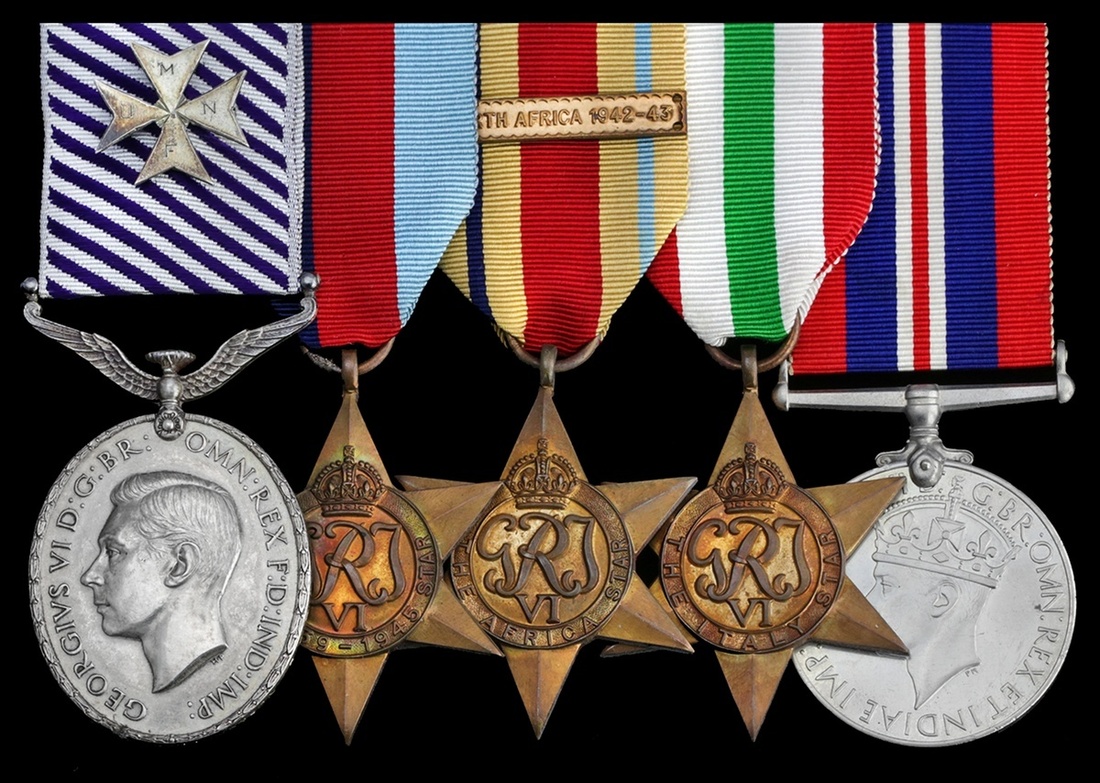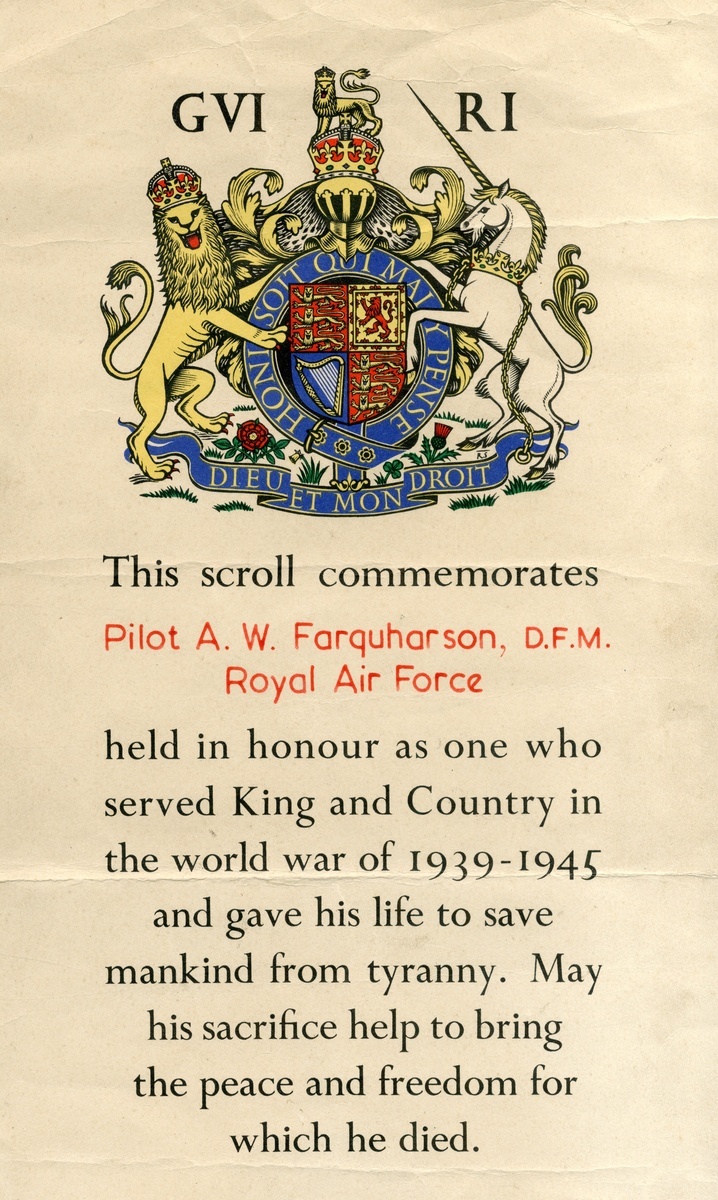Auction: 18001 - Orders, Decorations and Medals
Lot: 41
A fine Second World War night fighter's immediate D.F.M. group of five awarded to Pilot Officer A. W. Farquharson, Royal Air Force
Decorated for his gallant gunnery work in a Beaufighter of No. 46 Squadron in December 1942 - when he was wounded in the shoulder during a 20-minute combat with Me. 109s off the Tripolitanian coast and claimed one of them as a 'probable' - he raised his score to three confirmed 'kills' whilst operating out of Malta as an Observer/Radio Operator in Beaufighters of No. 108 Squadron
The last of those 'kills' was claimed in a patrol east of Syracuse on 12 July 1943 but the enemy aircraft exploded with devastating results, debris severely damaging his Beaufighter: he was unable to bale out as it spiralled into the sea
Distinguished Flying Medal, G.VI.R. (1365211 F./Sgt. A. W. Farquharson, R.A.F); 1939-45 Star; Africa Star, clasp, North Africa 1942-43; Italy Star; War Medal 1939-45, good very fine or better (5)
Sold with the recipient's rare silver Malta Night Fighter Unit (M.N.F.U.) badge. This small Maltese Cross was locally manufactured during the siege and only given to those Royal Air Force personnel who flew in the defence of the island. It is engraved on the obverse arms with the letters M-N-F-U and with the initials 'A.W.F.' on the reverse; photographs are known to exist showing this highly respected badge being worn - unofficially - in uniform.
D.F.M. London Gazette 5 February 1943. The original recommendation - for an immediate award - states:
'On 19 December 1942, this N.C.O. was Observer in a Beaufighter which was ordered with seven others to strafe lighters off the coast of Tripoli. After strafing they were attacked by Me. 109s and Flight Sergeant Farquharson was wounded in the shoulder. Their aircraft was slightly slower than the rest and received the brunt of the attacks. He told his pilot that he did not think he would be able to use the rear gun. A running fight continued for 20 minutes and cool implicit instructions given to his pilot for evasive action definitely saved the aircraft and crew. Towards the end of the fight Farquharson managed to fire his gun directing the pilot to turn to enable the gun to be brought to bear on the enemy aircraft. The 109 sheared off suddenly and may have been destroyed but no definite result could be observed as the other enemy aircraft were still around. This N.C.O. has displayed at all times keenness and devotion to duty of a high order.'
Alexander Watson Farquharson was born in the hamlet of Finavon, near Tannadice, a village in Forfarshire, Scotland in 1919, the son of Alexander and Betsy Farquharson. Educated at Blairgowrie High School in the county of Perthshire, he found employment near Perth as a tractor driver with Mr. Main of Windyedge Farm.
Enlisting in the Royal Air Force Volunteer Reserve in 1940, he qualified as an Observer/Radio Operator and was promoted to the rank of Sergeant.
No. 46 Squadron
Posted to the Middle East in February 1942, he joined No. 46 Squadron, a Beaufighter unit based at Idku in North Africa. The Squadron became operational as a night fighter unit in the summer and Farquharson flew his first sortie - with Pilot Officer H. S. L. Underwood - on 6 August. He flew two further sorties with Underwood in the same month, one of them leading to a 'contact' on the 21st, but the enemy aircraft broke off in a steep diving turn and contact was lost.
On the 31 August, however - with Warrant Officer G. W. C. Thomas as his pilot - Farquharson experienced a 'contact' of a closer kind. The resultant combat report takes up the story:
'A contact was followed by the Observer obtaining a visual of a single-engine aircraft 500 feet above and slightly ahead. This aircraft suddenly climbed steeply and came down behind our aircraft opening fire with tracer but no hits were experienced. Our pilot took immediate evasive action by climbing to port and the other aircraft overshot and was not seen again. Following this a number of contacts were made but all were unworkable owing to interference. A number of visuals were however obtained and fired at. The first was given a burst as it dived across from starboard to port but no results observed; the second was fired on from astern but an aircraft overshot and no results were seen and the third dropped a flare immediately in front of our aircraft which dazzled the pilot who nevertheless followed and opened fire on the enemy aircraft. Strikes were seen on the fuselage. It was lost amongst the A.A. and our pilot was told to go no lower. Later the exhausts of a He. 111 were seen. It was given a long burst from 400 yards but cannon stopped and no results were observed. After this R./T. went U.S. and our aircraft returned to base.'
During September Farquharson participated in two convoy patrols and one scramble, again with Thomas as his pilot. There are no operations recorded for Farquharson during October, although at the end of the month, following the 8th Army's advance from El Alamein, 46 Squadron carried out attacks on the retreating enemy columns in the Mersa Matruh area.
Immediate D.F.M.
In November 1942, the Squadron was reorganised as part of R.A.F. Coastal Command and provided convoy cover off Malta and Benghazi, in addition to anti-submarine patrols. It was, however, during a daylight 'offensive reconnaissance' of the Tripolitanian Coast on 19 December - with Pilot Officer Banbury at the helm - that Farquharson won his immediate D.F.M. The Squadron's Operations Record Book contains the following entry:
'Saw 4 'F' boats and 1 small trawler. Attacked barge nearest coast. A./A. from all barges. Hits seen. Our aircraft ran into 3 to 5 Me. 109's which attacked from rear. Our aircraft was damaged in tail and stern frame and port petrol tank but rear gunner of our aircraft gave 3 bursts and hits were believed to have been made on enemy aircraft. Our aircraft landed at Malta. The Observer was wounded in the arm.'
In January 1943, Farquharson was posted to No. 89 Squadron in Egypt and it was here that he commenced flying as Navigator/Radio Operator to Flight Lieutenant V. B. S. Verity. In the following month, they were ordered to Malta, where they joined No. 108 Squadron.
Malta - No. 108 Squadron
By early June, the Squadron had moved to Luqa and was operating with eight Beaufighter VIs, four equipped with Mark VII and four with Mark IV Airborne Interception Radar. Verity and Farquharson flew several sorties but without incident.
In early July, the Squadron's activities were stepped-up in readiness for the invasion of Sicily. The A.O.C. - Air Vice Marshal Sir Keith Park - briefed his aircrew, telling them that one third of the Allies' shipping tonnage had been concentrated in their area of operations and the responsibility for defending this Armada - as it lay off the coast of Sicily - would fall to 108 and 600 Squadrons, with a detachment from 256 Squadron.
As far as 108 Squadron concerned, it was charged with maintaining a nightly state of six aircraft and crews, which were to cover the two main landing beaches. These were Patrol Line 'A', a line parallel to the coast, 20 miles out to sea, between Licata and Cape Sealambria, and Patrol Line 'B' between Cape Passere and Syracuse. It was during just such sorties that Farquharson would contribute to the confirmed destruction of two enemy aircraft and likely another.
On 11 July - the day following the invasion of Sicily - patrols were flown off the landing beaches. Early that morning, with Warrant Officer Rimer as his pilot, Farquharson was vectored north off Augusta and obtained a contact and visual on a Ju. 88. Two bursts were fired at the enemy aircraft and strikes were seen along its fuselage and port wing and it was claimed as probably destroyed.
Continuing their patrol north, Rimer and Farquharson obtained a contact and visual on a second Ju.88. Their first burst of gunfire produced no obvious results but a second burst witnessed some convincing strikes and the enemy aircraft peeled off with its port wing alight. It was claimed as destroyed.
Journey's end
In one of those cruel twists of fate known to war, Farquharson was not due to fly operationally on the 12th. However, Flying Officer R. B. Cowper's Observer was taken sick and he was called-in as a replacement.
They set off on patrol at 0215 hours and, when east of Syracuse, Farquharson vectored their Beaufighter K8680 onto an enemy aircraft. It was identified as a Ju. 88 and Cowper opened fire from 200 yards, whereupon there was an instant flash and enemy aircraft exploded violently mid-air: their Beaufighter was struck by debris and its controls severely damaged.
Cowper instructed Farquharson to bale out but he was unable to open his rear hatch. He then told Farquharson to come forward and get out of front hatch. With the Beaufighter entering an uncontrollable spin, Cowper baled out. He was picked up from the sea by the Hospital Ship Aba and taken to Tripoli with only minor injuries.
Farquharson was never found.
The Squadron Operations Record Book contains a glowing testimony, noting that, among other observations, he was 'an exceptionally keen and thoroughly competent Navigator/Radio. He never missed an opportunity of flying whether on a training flight or on operations, and if any pilot needed an Observer, he would nearly always be the first to volunteer.'
It adds that 'his loss came as a great shock to his colleagues, who considered him as faithful a friend as they did a skilful Observer … since joining this Squadron he had taken part in the destruction of three and probably a fourth enemy aircraft.'
Farquharson has no known grave and is commemorated on the Malta Memorial.
Sold with the recipient's original illuminated Memorial Scroll, a wartime portrait photograph and a pair of school memorial photographs.
Subject to 20% VAT on Buyer’s Premium. For more information please view Terms and Conditions for Buyers.
Sold for
£2,600









